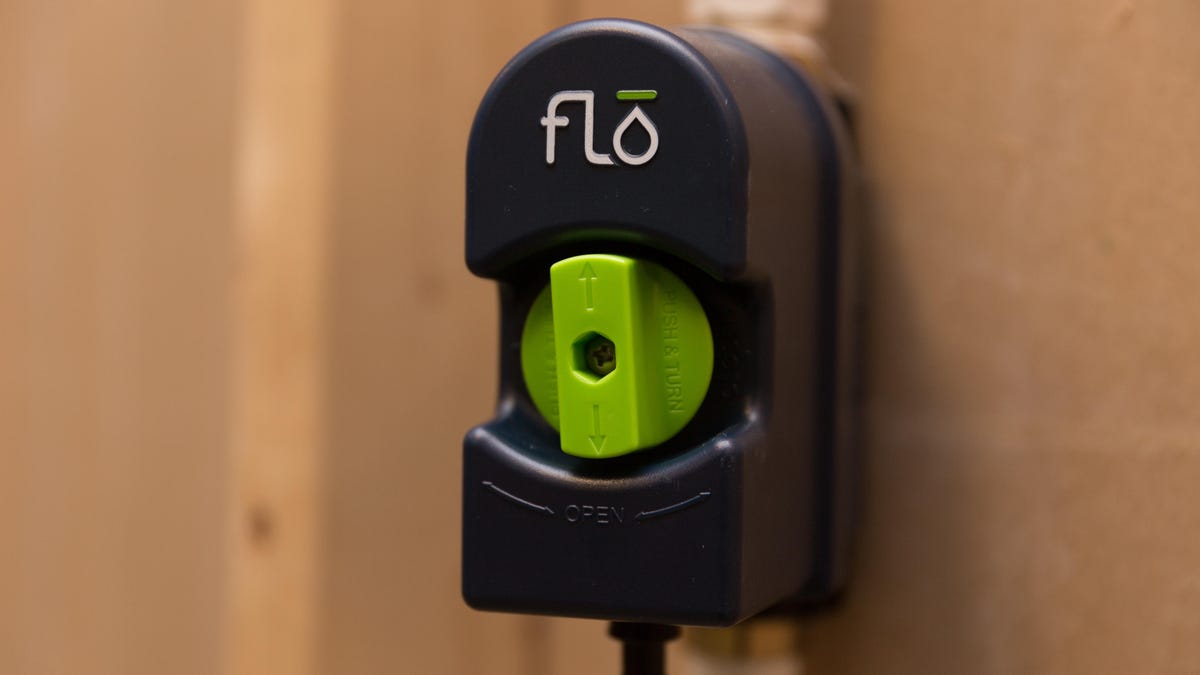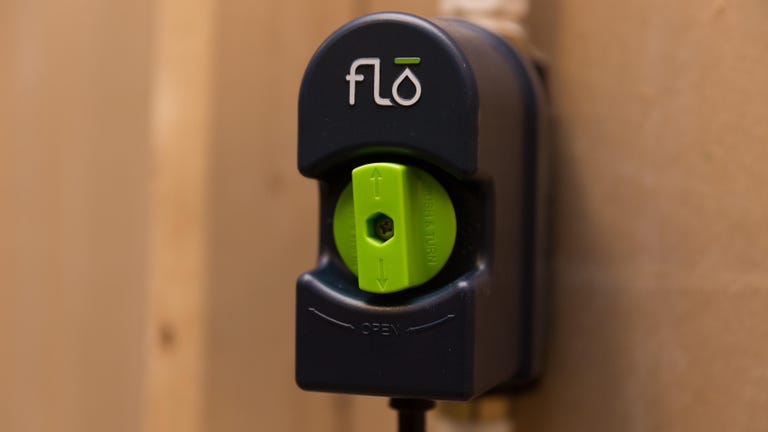 Why You Can Trust CNET
Why You Can Trust CNET Flo Home Water Control and Monitoring review: This smart water monitor dives deep into water data
This Wi-Fi connected smart water monitor measures flow rate, water pressure and temperature for detailed, real-time data.
Creating a smart home can mean more than just voice-controlled gadgets. From appliances to your home's utility system—you can smarten the pieces of your home you rely on every day. Flo is a $500 smart water monitor designed to do just that. With remote access to your home's plumbing and real-time data through the Flo app, this water watching device does more than the average leak detector. Still, at $500, it's hard to recommend over less expensive, equally reliable leak detectors.
The Good
The Bad
The Bottom Line
Flo attaches to your main water supply to monitor the flow rate, temperature and pressure of the water coming into your home. Flo weighs about 2 lbs and measures 5.9 inches tall, 5.75 inches long and 2.6 inches wide. With Flo installed and connected to your wireless network, you'll get remote control of your water from anywhere. Flo can even shut water off on its own, if something looks really wrong.

Flo attaches to your main water supply line and provides detailed data about your water consumption.
Installation
I took a look at Flo last year and was eager to put it to the test in our CNET Reviews lab. I wasn't able to test Flo in a residential home, but with the help of our labs manager, Steve, I installed and connected Flo to a custom wall of pipes built to simulate the water flow in a one-story home. The only quirk I experienced had to do with the learning period. Instead of the standard 7-day learning period, it took nearly two weeks for Flo to catch on to the patterns of my water usage.
The team at Flo recommend hiring a licensed plumber for installation, but you can do it yourself if you feel comfortable. Here's what you'll need for Flo to work correctly:
- A main water supply line above ground and accessible near or in your home
- A main water supply line with a diameter of 1 1/4 inches or smaller
- iOS or Android smartphone for the Flo app
- A 2.4GHz Wi-Fi network
- Standard 120V power outlet near main water supply line
Flo installs on your main water line, where the public water supply meets your home's plumbing. If you have a well water system, Flo is still compatible, but you'll need to install the device on the potable water line after the well system pump and before the tank. Flo is rated for an ambient operating temperature of 10 to 140 degrees Fahrenheit. If your home's installation location for Flo consistently sees temperatures beyond that range, Flo might not perform at its best.
Flo attaches to most water supply lines, including well systems.
Flo comes with a printed installation guide with step-by-step instructions for how to connect the device to your water supply and your 2.4GHz Wi-Fi network. Also included in the box are hardware like brass tailpieces, o-rings, and spacers to connect Flo to your system and seal it well.
The Flo app
With the Flo app downloaded to your iOS or Android device, you'll answer a set of questions to tell Flo some of the more specific features of your home. Have a pool or spa? Flo wants to know. One story or two? This also makes a difference. Once the device and the Flo app are set up, Flo spends 7 days learning the typical patterns and stats of your home's plumbing system. During that learning period, you can see your plumbing stats in real time, but not every feature is accessible.
The Flo app offers Home, Away and Sleep modes, which won't work until after the learning period ends. Home mode is intended for everyday use. Away mode works like a vacation mode, designed for when you'll be gone for extended periods of time. Sleep mode functions like a do not disturb setting, so you can use extra water or do activities that might change your water's readings without being alerted or having the water shut off automatically.
The Flo app dashboard displays water data in three gauges.
The data Flo collects is down to the decimal and surprisingly interesting. A dashboard in the Flo app displays gauges for water pressure (PSI), flow rate (gallons per minute) and temperature, all in real time. Flo can't monitor humidity, but it can determine a leak as small as one drop per minute. There's even an animation at the bottom of the app depicting your home's water flow, along with a toggle switch for turning off the water remotely. The app is simple to navigate and displays data in an easy to understand way. It's also fun to watch the water flow through the animated pipe in real time, but I'm easily entertained.
Flo's remote shut-off capability is great if you've left town and forgot to turn off the water or if Flo alerts you to an issue while you're not at home. Being able to shut things off can make you feel less like you need to drop what you're doing and rush to stop a flood. Flo can shut off your water on its own if it detects a large leak or prolonged water use. To test this out, I left a sink faucet on at full blast. Flo shut the water off after 33 minutes of running water. Flo was also quick to pick up a small drip. I punched a small hole in one of our water lines, so that it leaked a drop about once every 10 seconds. Flo alerted me to the small drip, but doesn't shut the water off for something that small. You can customize Flo's alerts to include push notifications, emails, texts and phone calls.
Is it worth it?
That depends. Flo's high price is tough to swallow, and I think value is in the eye of the beholder here. At $499, it's not cheap. Someone who doesn't have recurring plumbing issues might not be willing to shell that much cash for water monitoring. On the other hand, if you've ever dealt with major plumbing problems, $499 might sound like a bargain, especially for the option to shut off your system remotely the instant something goes wrong. If you have a vacation home or rental property, Flo's remote access and reliable alerts is a worthy investment in a property that isn't your primary residence.
Pricey as it is, Flo isn't even the most expensive option out there. Phyn Plus, another smart water monitor released this year, costs $850 plus an installation fee. We haven't tested Phyn yet, but it offers water monitoring smarts similar to Flo, with the addition of technology that measures water pressure 240 times a second and uses machine learning to know exactly which fixture is leaking. The $799 Buoy smart water monitor can also shut off water remotely and identify individual fixtures. That's something Flo can't do.
When Flo detects a major problem, it will shut off you water supply and notify you via the Flo app, call, text or email.
So, what else can you get in the Flo price range? Leaksmart, a bundled system with a hub, leak detector and shut-off valve costs $425. We didn't prefer it for the required hub and poorly designed app. FortrezZ, another leak detector and shut-off valve combination with a base price of $416, can also shut off your water if it detects trouble. Units costing hundreds of dollars might seem outrageous compared to a $50 leak detector. However, they can turn your water off and that's the key difference. The fact that these devices can not only detect trouble but take action to mitigate it is reflected in the price tag.
While Flo is great at providing water data, collecting consumption information and alerting you to abnormalities, it can't pinpoint a leak. You'll know that somewhere in your home something isn't right, but it's up to you to find the problem. Flo's tutorials and troubleshooting guides are good resources for where to start when it comes to finding a leak (hint: it's probably the toilet), but Flo can't zero in on the source of the problem.
You can't tie third-party sensors into systems like Flo and Phyn. If you know a particular plumbing area or appliance is prone to leaks, a smart leak detector like the Roost Smart Water Leak and Freeze Detector might be a better fit. Both Phyn and Flo seem to be best suited for having a broad picture of your plumbing system's overall health. Sensor-based systems like FortrezZ and Leaksmart allow you to purchase additional sensors to watch multiple places in your home and can also shut water off automatically.
Flo gives you a reliable, data-rich heads up on potential issues signaled by changes in flow rate, water temperature or water pressure. If you know your home has water issues, Flo can offer great peace of mind. You'll get plenty of real-time data and remote control over your home's water system. Still, this $500 purchase is hard to recommend to a home with a reliable, healthy water system.


